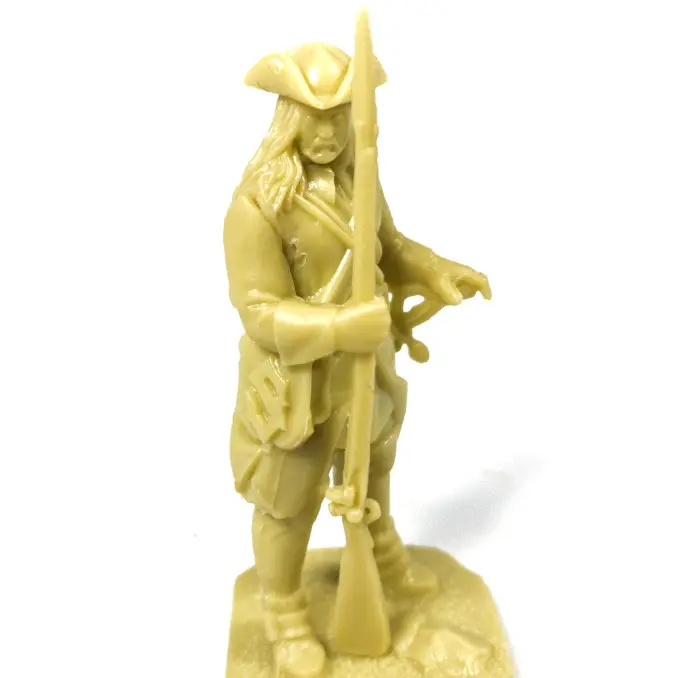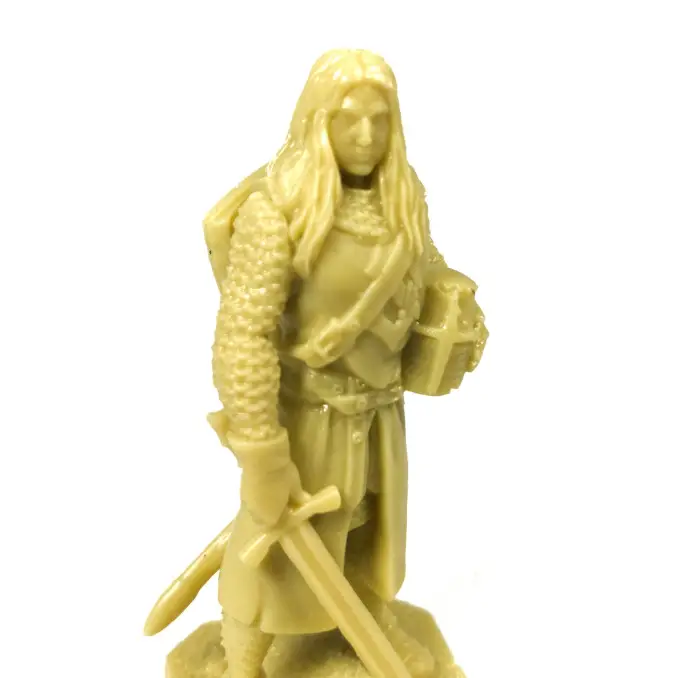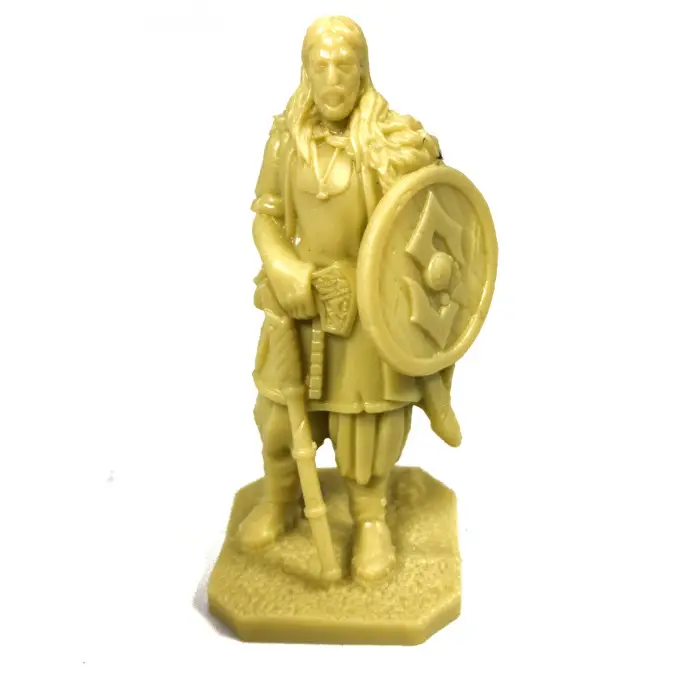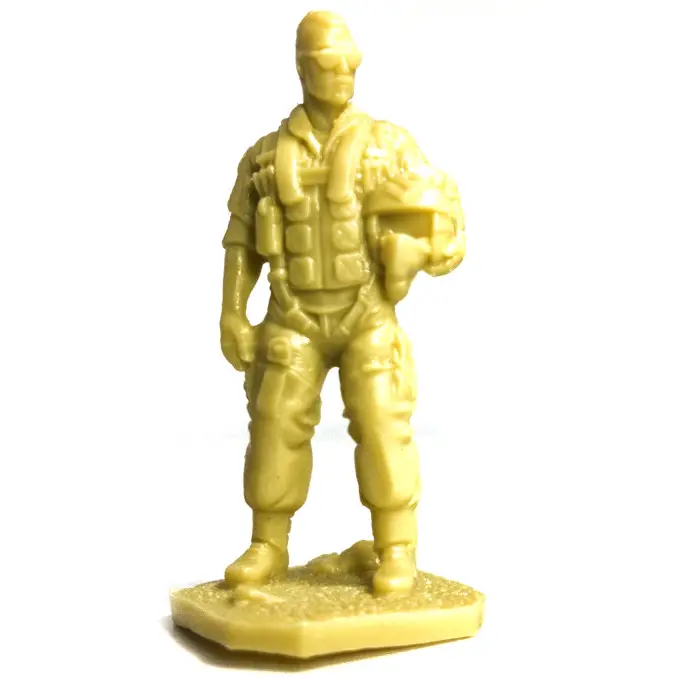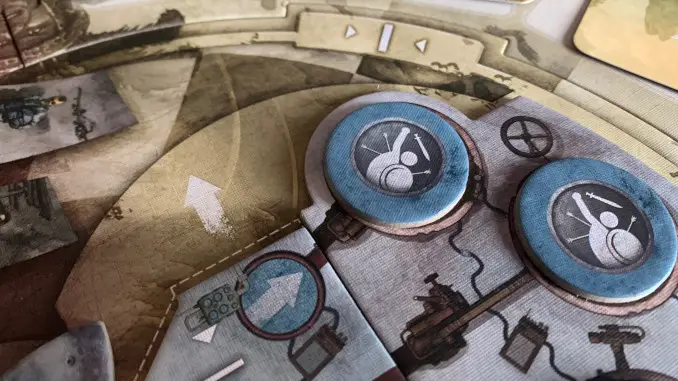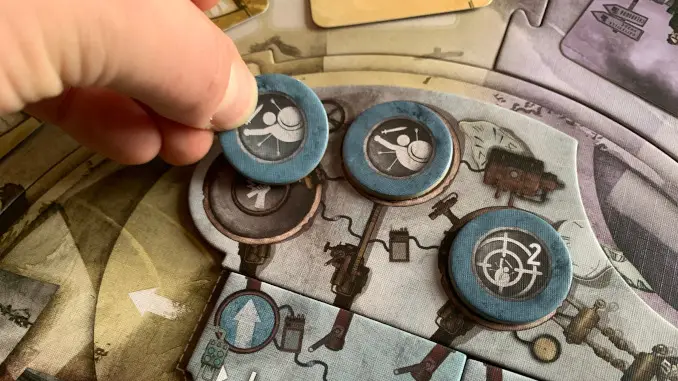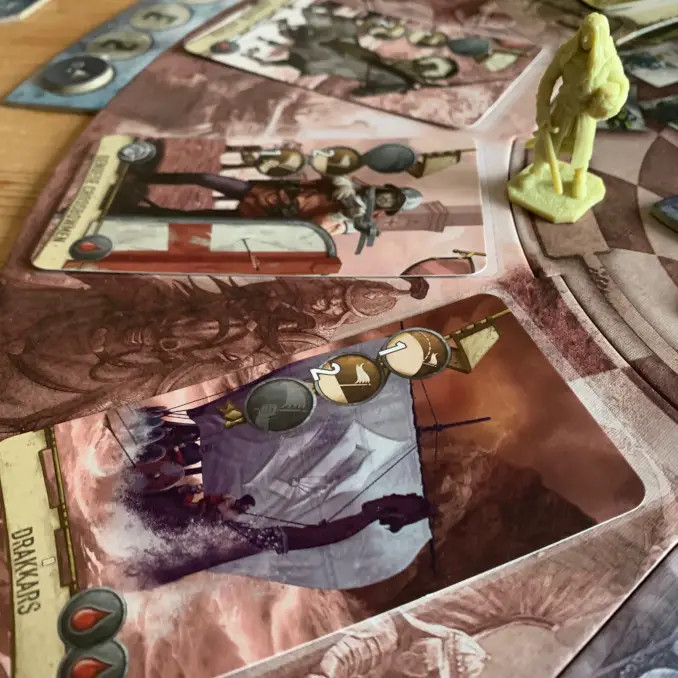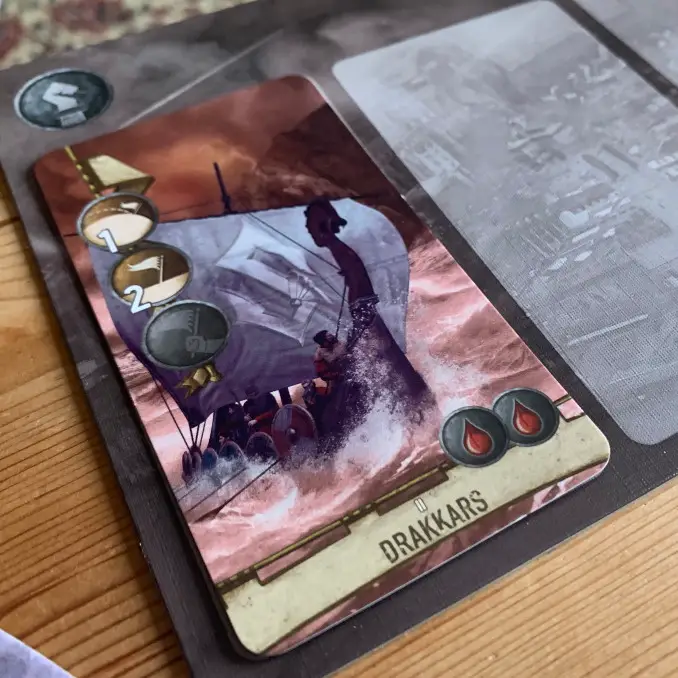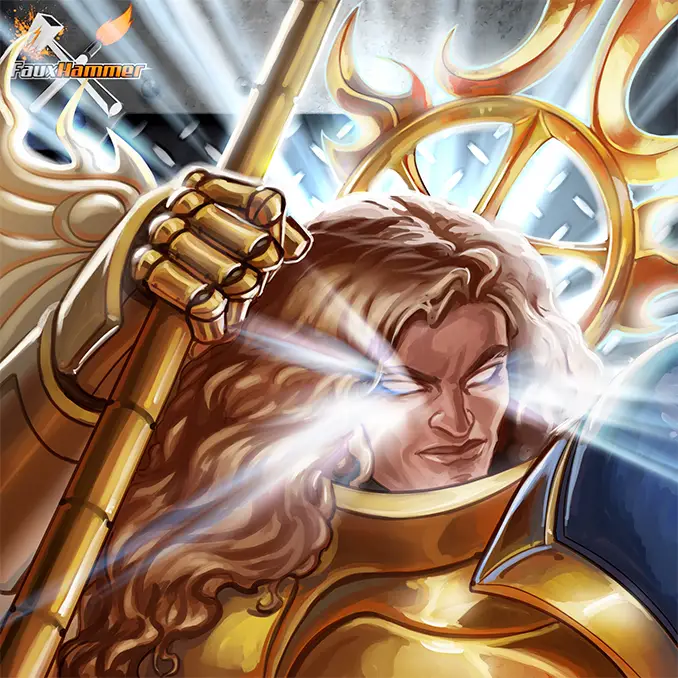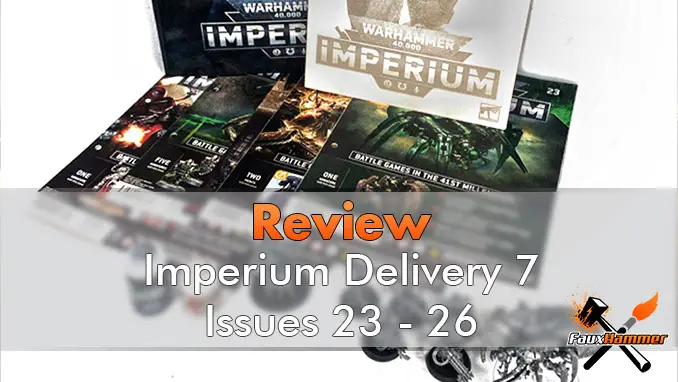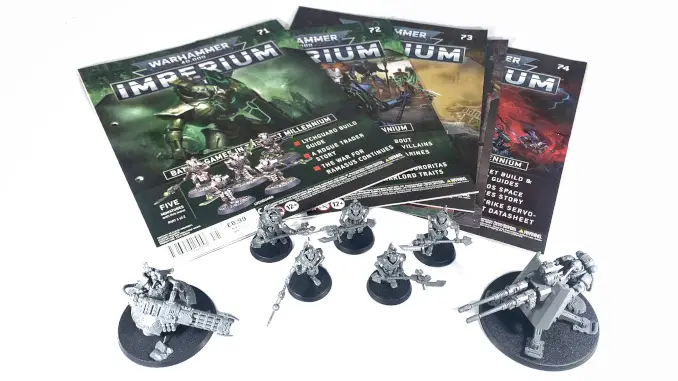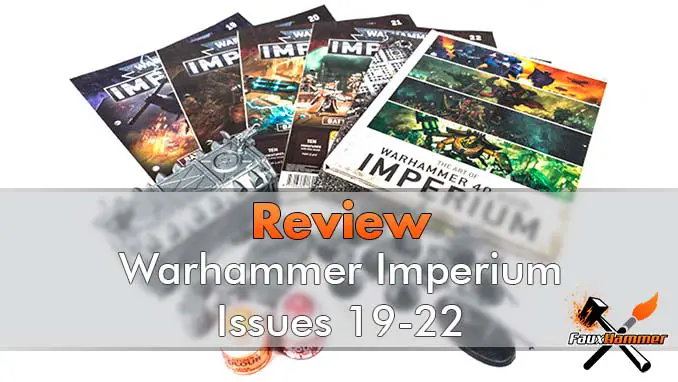Sabaton: A Battle Through History Board Game Review
In our latest deviation for scheduled Warhammer and Games Workshop-related content, we take a dive back into the distant past with Swedish power metal legends Sabaton in their new board game. A Battle Through History aims to take players on a journey through the history of human conflict to meet some of the heroes who have shaped the course of humanity during its darkest moments.
Please Note: This site uses affiliate links. Our Affiliate Partners are shown below
(Affiliate links will result in compensation to the site on qualifying purchases)
Click this link & buy your hobby stuff from Element Games for the UK & Europe to support FauxHammer.com – Use Code “FAUX2768” at the checkout for double reward points.




Our Affiliates / Hobby Stores
- UK: Element Games, The Outpost, Wayland Games, Mighty Lancer, Goblin Gaming, Forbidden Planet, Model Scenery Supplies, eBay, Amazon
- US/Canada: MTechCave, GameKastle, eBay (US), eBay (CA), Amazon
- Germany: Taschengelddieb
- Europe: eBay (DE), eBay (FR), eBay (ES), eBay (IT), Amazon
- Australia: eBay, Amazon
- Global: RedGrass Games, Warcolours
- 3D Printers: Phrozen 3D, Elegoo, Anycubic
FauxHammer – Latest Video on YouTube
Sabaton: A Battle Through History Board Game – Summary
Whilst it’s an at times confusing and hard to pick up game, there remains a lot to like in Swedish power metal band Sabaton’s A Battle Through History. It’s unique blend of historically-inspired deck-building and its amusing time-travelling premise ensures that fans of board games and Sabaton alike will find something to enjoy in this box.
Sabaton: A Battle Through History Board Game – Introduction
Since the start of this year, we’ve been extremely Warhammer-heavy on the content we’ve put out on FauxHammer.com – and not without reason. There have been a host of exciting new releases and announcements, from new Aeldari models in the Eldritch Omens box to the very exciting Stormbringer partworks magazine.
So, it’s time for something else.
This is the third entry in this little FauxHammer.com mini-series, where we try and show you some non-Warhammer-related products that you, dear reader, may (or may not) have heard of, and may (or may not) be interested in. So far, we’ve had a look at the awesome World of Warcraft: Wrath of the Lich King Board Game and Modiphius’ excellent The Elder Scrolls: A Call to Arms miniatures wargame. If there’s anything you’d like us to try and cover, let us know in the comments.
In what appears to be yet another deviation from the established norm of looking at videogame-inspired games, today we’re having a look at a board game made by a Swedish power metal band.
This, of course, means I’m going to use this gif again.
There’s a chance you might not have heard of Swedish metal titans Sabaton if the heavier side of music isn’t really your sort of thing. As far as metal bands go, however, they’re one of the biggest names in the world right now. With their own festival and cruise, the camo-clad Scandi five-piece have made their mark on the musical world by writing songs commemorating historical events, primarily with a focus on warfare and the people who are either affected by of effect great change within the field of conflict.
Part of what’s made Sabaton so popular with their fans is that they don’t play favourites. Their entertaining and driving music tries to remain objective in its approach to the history it deals with and often focuses on less “mainstream”, for want of a better word, participants in said conflicts. This has won them considerable purchase amidst European nations, such as Poland, where they played to 600,000 fans in 2015 at the Przystanek Woodstock Festival as the headline act.
Sabaton do, however, tread a difficult line with their music. Whilst they don’t try and glorify conflict and killing, and instead try and focus on recounting events from either an historical perspective (such as on their 2012 album Carolux Rex, which charted the rise and fall of the Swedish Empire under Charles XII), or commemorating the actions of certain individuals (such as on their 2014 release, Heroes), they have often been mistaken for being right-wing, pro-war nationalists – claims the band have always vehemently denied. Their aims are, and always have been, to educate and to entertain.
In fact, this is something they’re acutely aware of in their A Battle Through History game. On the first page of the instruction manual is a disclaimer detailing that the game and the band are in no way trying to glorify the use of violence or weapons, and that the product – like their music – is designed only to teach and provide entertainment to their fans.
It shouldn’t need to be said, but this is obviously how we at FauxHammer.com feel as well. We are not covering this product as part of a political or social agenda: we were sent this product to review free of charge, and our coverage of it is done from the perspective of a pair of board game lovers, writing about a board game that caught our interest, for people of similar interest.
I’ve seen Sabaton live twice: once in 2014 and again in 2016, and even had the pleasure of meeting a few of the members afterwards at the latter date. As both a history graduate and a long-time fan of heavy metal, I’ve always had a bit of a soft spot for Sabaton. It turns out, so does FauxHammer himself, so when the band announced their A Battle Through History board game a few months back, I knew I had to get hold of a copy for the site.
Let’s dive right in and see what we have.
Sabaton: A Battle Through History Board Game – Unboxing
Here’s the box in all its glory. As the premise of the game revolves around exploring different eras of history and discovering various heroes and notable military units. The artwork depicts a number of the game’s available warriors – all clustered around Sun Tzu, the sixth century BC Chinese philosopher and general accredited with the creation of The Art of War.
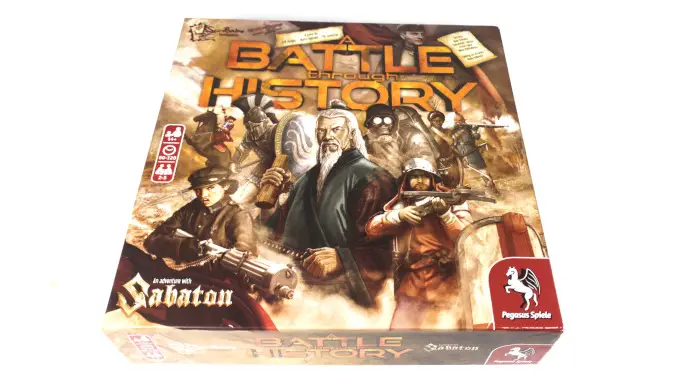
Opening up the box we-…
Wait, what?
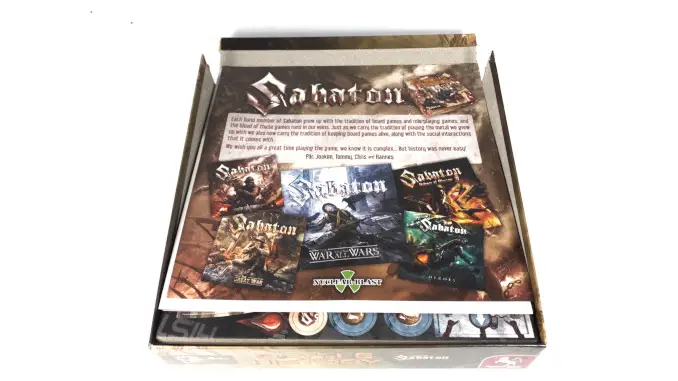
One of the box walls has completely torn at both corners. When I lifted the lid, everything came spilling out.
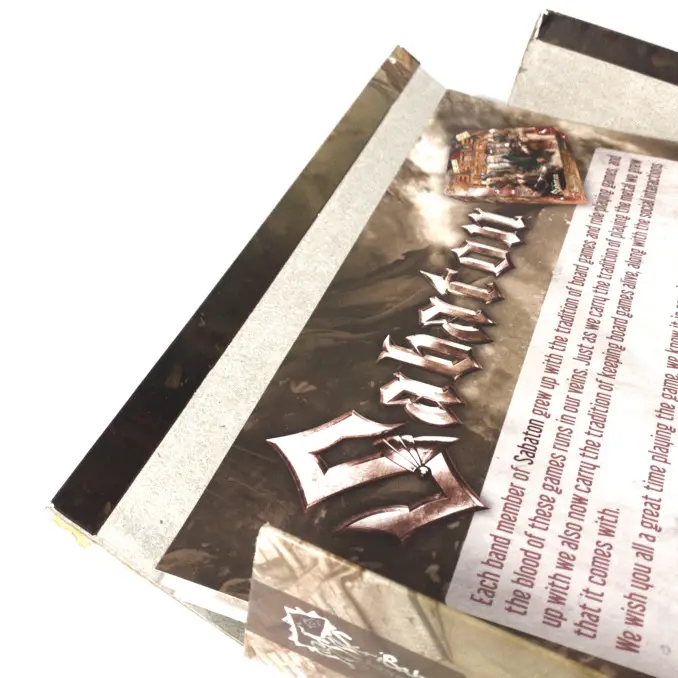
In fact, as we’ll see as we keep unboxing, it looks like someone’s used this box as a football, as a lot of the tokens and other cut-out card items in the box have been knocked out of their frames.
Anyway, has the box not been split, the first thing we would’ve seen upon the box being opened would have been this note below.
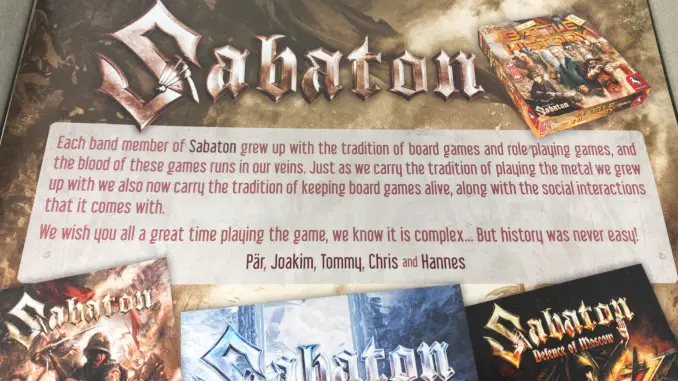
I feel this could’ve probably used a proof-read. And I also kinda feel that being warned that the game is difficult isn’t necessarily the best first impression to give someone as they open up the box they’ve just purchased.
Okay, so perhaps we’re not off to the best start. But let’s persevere and see what’s beneath this note.
A “Historical Booklet” and no less than five identical instruction manuals. One is in English, one in French, one in German, one in Italian and another in Spanish
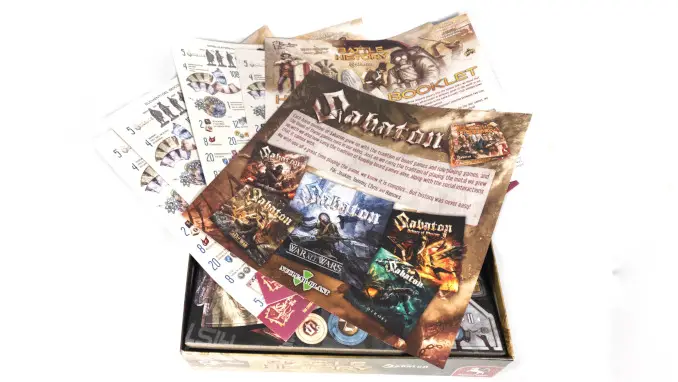
Blimey. Right, beneath all this paper are your cardboard tokens and push-out parts. There are four frames in total – but mine were in a bit of a state after whatever had happened to them in transit. Luckily, nothing was too badly damaged.
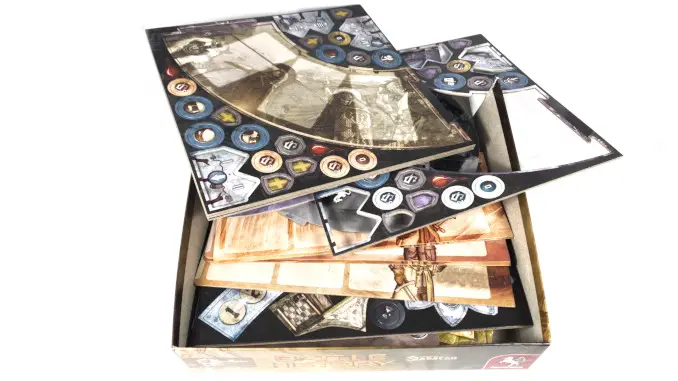
With the tokens and other stuff that dwells on the perforated boards out of the way, we have everything else at the bottom of the box: cards, dice, figures, and a few further boards for players to use.
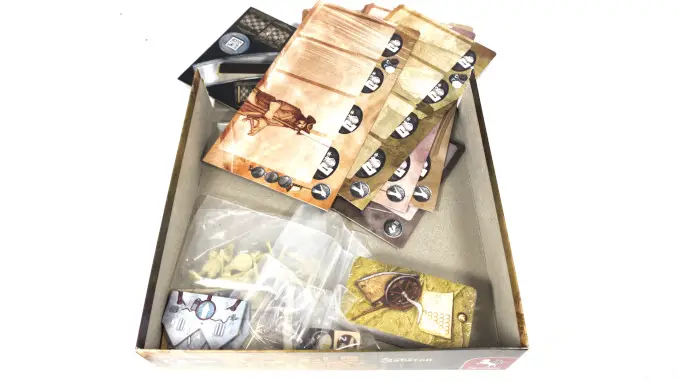
It’s a shame the box arrived looking a little worse for wear, but this is in no way the fault of Pegasus Spiele, who make the game, nor should be taken as a reflection on the overall product.
There is an unbelievable amount of stuff in this box, too. We’ll have a closer look at it all now.
Sabaton: A Battle Through History Board Game – Contents
There is a vast amount of stuff in the Sabaton: A Battle Through History box.
- 5 x Rules Manuals (one in English, one in Spanish, one in Italian, one in German, and one in French)
- 1 x Historical Booklet
- 5 x Miniatures of the band
- Joakim Brodén (vocals) as a Twenty-First Century Fighter Pilot
- Pär Sundström (bass) as a Samurai
- Chris Rörland (guitars) as an Eighteenth-Century Swedish Solider
- Hannes Van Dahl (drums) as a Viking
- Tommy Johansson (guitars) as a Crusader Knight
- 1 x Main Gaming Board, made up of:
- 4 x Quadrants for the Main Board
- 1 x Gears of History Board (which requires some assembly)
- 1 x Round Tracker and its Counter
- 1 x Headquarters
- 2 x Dice
- 88 x Counters, Tokens and Tiles
- 8 x Damage Counters
- 20 x Link Counters
- 8 x Honour the Arms Tokens
- 12 x Time-Travelling Tiles
- 20 x Prowess in Battle Tokens
- 20 x Warfare Tokens
- 5 x Attacker Boards
- 1 x Defender Board
- 140 x Cards, as:
- 40 x Base Units
- 60 x Elite Units
- 8 x Hero Units
- 32 x Relic Cards
We’ll break this down now and have a look at everything in turn. There’s a lot to get through here, so strap yourself in!
Cards
There are 140 cards in the A Battle Through History box, 108 of which represent heroes and units that players can recruit to bolster their own forces, and 32 of which represent historical relics.
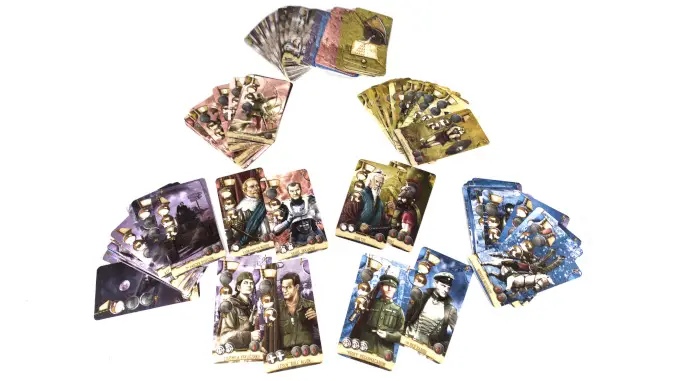
In the image above, you can make out the 8 Hero Units in the centre-bottom of the image. Players have the opportunity to recruit Leonidas of Sparta, Sun Tzu, legendary Samurai Saigō Takamori, Swedish Emperor Gustavus Adolphus (also called the Lion from the North), Canadian First World War sniper Francis “Peggy” Pegahmagabow, German flying ace The Red Baron, stretcher-bearer Leslie “Bull” Allen who single-handedly carried twelve wounded men (not all at once, duh) from the battlefield of Mount Tambu, and Russian sniper Lyudmila Mikhailovna Pavlichenko, known as “Lady Death” to her enemies.
Alongside such legendary warriors and heroes of war, players can also recruit Base and Elite Units to their forces. There’s a dizzying array of units available, with everything from Persian Cataphracts and Greek Hoplites to tank divisions, U-boats, and even the Bismarck.
The artwork on the cards is excellent, with each hero and other unit rendered in tasteful and era-appropriate imagery. The gaming information is also clearly displayed on each card, so players will be able to find their appropriate stats at a glance.
Dice
There are only two dice in the box: one Strong die and 1 Risky die. The Strong die is on the right in the image below, the Risky die is on the left.
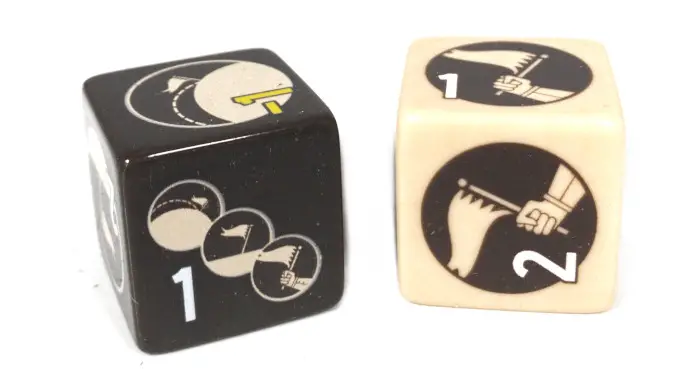
They’re large, chunky dice. They won’t disappear down the side of the sofa very easily, and they’ll be easy to spot if they find their way off the edge of your table and make a dash for cover underneath a cupboard or other sideboard.
Tokens, Counters and Other Markers
There are a ludicrous amount of different tokens and tiles in the A Battle Through History box.
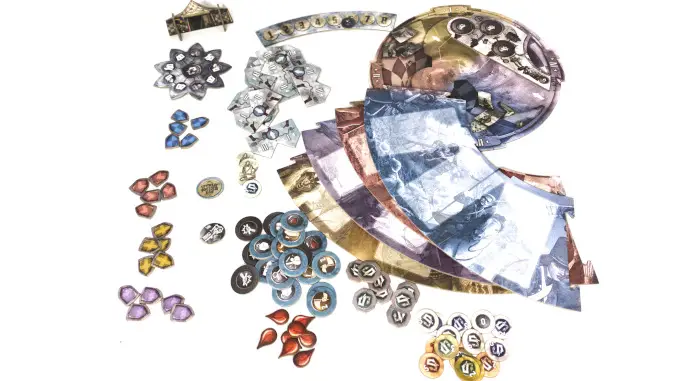
So, referencing the picture above, we have the Headquarters in the top left-hand corner. This is a little stand-up tent assembled by slotting together three push-out components. Immediately next to it is the curved Round Track and its Counter. Skipping down a row, we have the nine-pointed Gear that attaches to the Gears of History Board via a small screw (provided). The Gears of History Board is that enormous circle and four curved quadrant tiles immediately beneath it.
Next to the nine-pointed gear is a pile of Time-Traveling Tiles. The blue, red, yellow and purple shields running down the left-hand side of the image are the Link counters. The blood-droplets at the bottom are Damage Counters, and immediately above them are a sprawling pile of Warfare tokens. Finally, we have a bunch of stuff with Sabaton’s stylised “S” on it. 8 of these are octagonal Honour of Arms Tokens (next to the Damage Counters) and the others are Prowess in Battle Tokens.
There are also two other tokens, one with a QR code on that takes you to a website with some hints on how to play the game on it, and another with “ScriBabs Publishing & Artwork” and the Sabaton logo on it. These aren’t used in the game.
So yeah. A lot a stuff.
A lot of it looks quite similar, too, which might make the pieces difficult to differentiate from quickly during a game – but we’ll look at that later.
Assembled, here’s how the Gears of History Board looks.
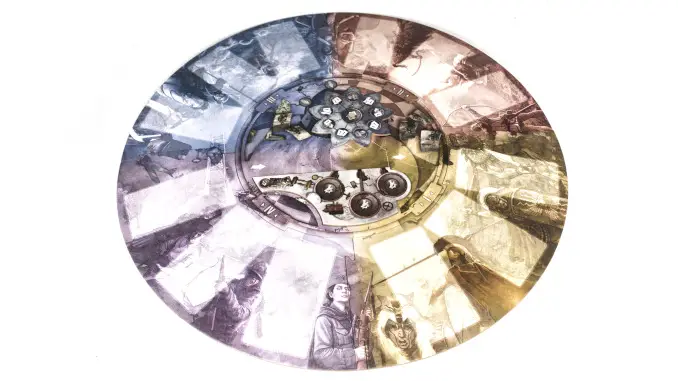
Each quadrant refers to one of four Eras: the yellow is Era I, red is Era II, blue Era III, and purple Era IV.
Also in the box are a number of boards (the Attacker Boards are pictured below) upon which players build their decks whilst playing the game.
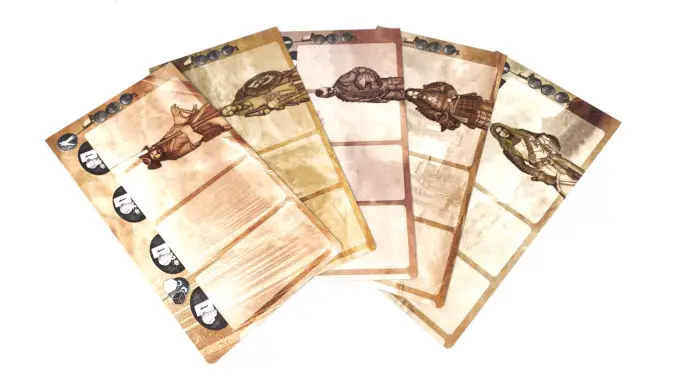
We’ll give everything a proper play-test in the moment and see just what the game’s like and how easy it is to navigate through all these pieces, boards, tokens and other colourful bits of paraphernalia. Generally speaking, though, the cards, boards, tokens and tiles in the box are of very high quality. They’re very durable and the artwork is good-quality and consistent.
Miniatures
The miniatures in the A Battle Through History box are quite, shall we say, unique.
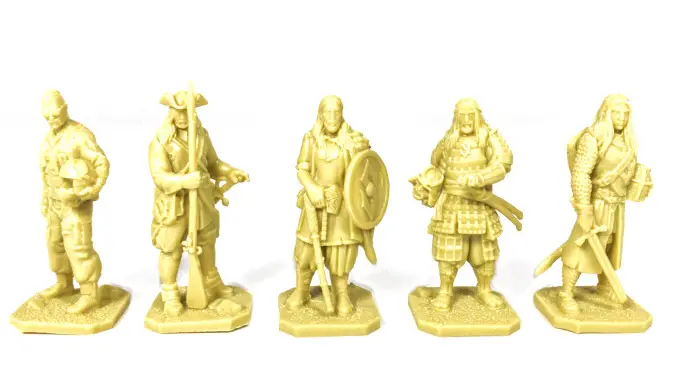
Each miniature represents one of the five members of the band, each sculpted to look as if they are wearing armour and wielding weapons from the period of history explored in the game.
When compared to the usual calibre of miniatures we usually look at on FauxHammer.com, they leave a little to be desired. Whilst it’s clear enough who’s who and what’s what on each figure, people used to the intricate level of detail expected on, say, your average Games Workshop miniature might be a little disappointed.
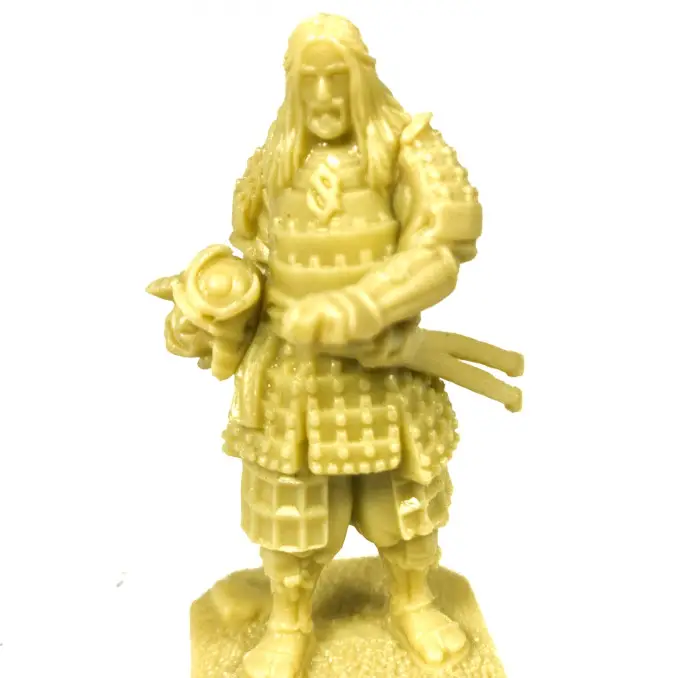
But where GW figures are intended to be both painted and played with – and in some spheres, the emphasis is often more on the painting than the playing – these figures’ primary function is to be used in the game. They likely aren’t even intended to be splashed with any paint. Sure, whilst they certainly could be painted, and I’m sure some people would do an incredible job. People who are looking for some weird and wonderful figures to up their painting skills on, are best off looking elsewhere.
That said, these are pretty amusing and do bring a smile to the face. Fans of the band will get a kick out of seeing the musicians dressed up in suitable period costumes. Once again, they’re all pretty accurate (though Tommy’s sword does look to be missing its point, and I can’t tell if this is due to damage or design) and done in good taste.
Historical Booklet
One of the things I actually really like about the A Battle Through History game is the Historical Booklet that comes with it.
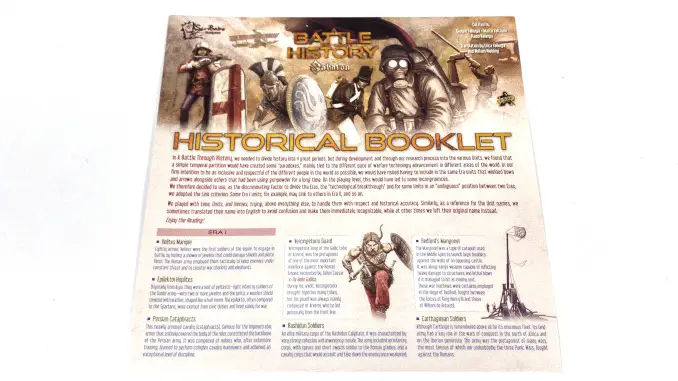
As I said at the start of this review, Sabaton as a band have two aims with their music: to entertain and to educate. Whilst the A Battle Through History game is, at its core, about playing a board game and having some fun, the inclusion of this booklet does help achieve that second aim: teaching people about the past.
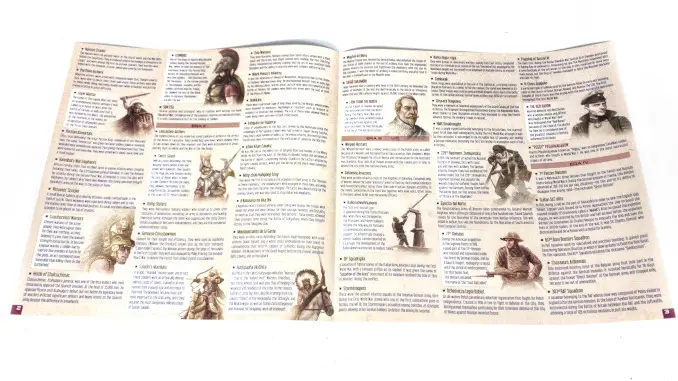
Through the course of a game of A Battle Through History, players will come into contact with all kinds of people, units, weapons and vehicles. All of these are drawn from the pages of the past. The Historical Booklet aims to provide a little context to the real-world things that have inspired the cards that players will build their decks out of.
It’s a really thoughtful and interesting inclusion, and one that shouldn’t be overlooked. Sure, the content of the Historical Booklet is sparse and won’t help you pass your history exams, but they do scratch the itch of wonderment that one may get when they draw a brand-new card into their hand. It may also inspire players to take their research further if anything, in particular, captures their attention.
As a staunch believer that one should always strive to be learning throughout their life, and the holder of a Master’s degree in Medieval History, this booklet gets a big thumbs-up from me. I think it’s an excellent and truly inspired inclusion in this box.
How to Play Sabaton: A Battle Through History Board Game – Playtesting
The basic premise of A Battle Through History is as unique as it is ridiculous. You are a time-traveller, referred to as a “Sabaton” (a bit weird, as a “sabaton” is actually a piece of armour worn on the foot), visiting various locations and events in the past to recruit mighty warriors and famed heroes of old to your cause.
Playtesting: Set Up
The board requires a lot of set up. The instructions on how to do this are clear enough and fairly straightforward, so getting all the necessary kit out on the table is easy enough – if long winded. You might, however, find out that you run out of tablespace…
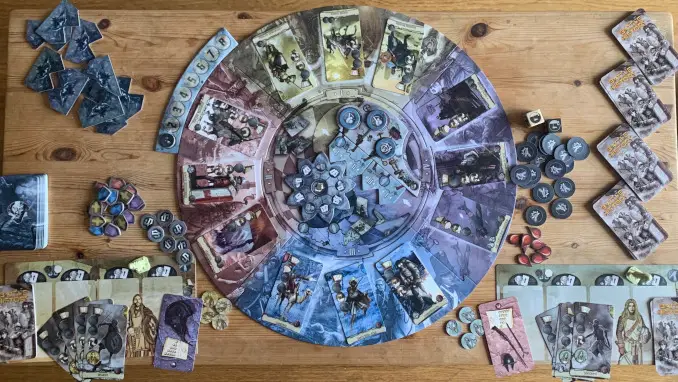
…like I did.
But then again, I don’t have a particularly large coffee table, measuring in at 105cm by 55cm.
In order to set thew game up, you need to assemble the board, shuffle those pointy Time-Traveling Tiles and place them face-down somewhere, mix the Warfare Tokens together and place them somewhere everyone can reach them, and then begin building your deck.
Each player needs to have a deck of cards to play and battle with. In order to prepare these, players must:
- Be allocated their Attacker Board (this’ll match whichever band member’s figure they’ve decided to use)
- Shuffle and draw 1 Relic Card each
- Allocate decks of Base Units to each player, shuffle them, and draw 4 cards to form your base deck
- Give each player their appropriate Prowess in Battle Tokens and ensure the Damage Counters, Link Counters, Honour of Arms Tokens and Combat Dice are all placed so everyone can reach them
With everything out and set up, the game can begin. The game is played between 2-5 players. For this review, I was limited by both available (and willing) victims friends to play with, so this test was carried out with only two players: myself and, making another appearance on FauxHammer.com, my partner Lizzie.
Playtesting: Playing the Game
The game is made up of either 6 or 8 Rounds. In each Round, each player takes a Turn. Each Turn is made up of three Phases. These phases are Time Travel, the Battle and finally Restoration.
Phase I: Time Travel
The first phase, Time Travel, requires players to “Activate the Gears of History”, “Prepare for Battle”, and finally, “Time Jump”. So, the first thing a player needs to do at the beginning of their turn is decide, into which of the four Eras (those coloured quadrants on the Main Board) they want to jump into. To do this, a player must draw one Time-Traveling Tile from the pile and insert it into the gears of History – that’s the rotating cog bit in the middle of the board. Players then have to push their tile into the gear until it’s in the “Active Position”. You’ll knoe it;d in the active position, as a number of arrows on the board will line up with some on the cog and your tile.
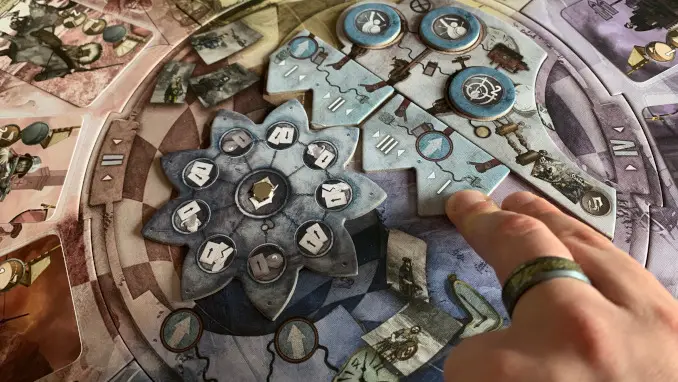
There should only be two Time-Traveling Tiles on the board at any one time, so when you push one into the gear, one should always be pushed out and discarded. Players can do this up to three times in their turn.
Once a player is happy with how the gear looks, they move on to the Prepare for Battle part of their turn. They can now do a number of things. The first is draw the Warfare Token indicated by the Gears of History and add it to their personal area for use later.
The second thing they can do is carry out the pair of actions indicated by the arrows elsewhere on the gear.
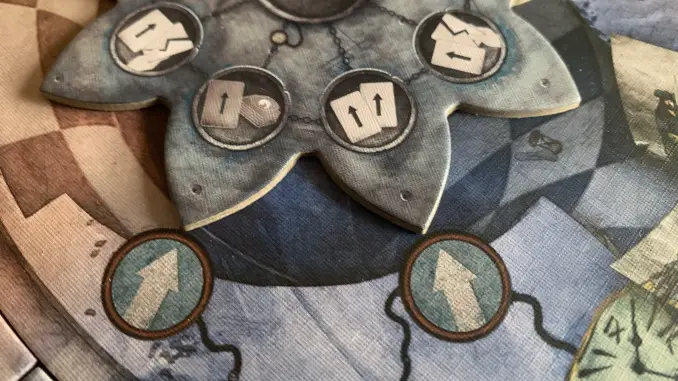
There are four possible actions available to the player, but only two will ever be available due to how the gear turns. Players will be able to either draw 2 cards from their personal deck; look at their discarded pile and choose 1 card; dismiss 1 unit from their hand and replace it with 1 from their deck; or shuffle their discard pile with their deck to create a new deck. In the image above, the options available are to draw 2 cards or look at the discard pile.
Once all these actins have been resolved, the player can then perform a Time Jump to an Era. The Eras available to the player are indicated on the Time-Traveling Tile currently in the Gears of History – either I, II, III or IV. Once you’ve decided which era you wish to jump to, off you go. You place your figure anywhere within that quadrant of the Main Board as an indicator as to where you are. With that, you progress to Phase 2: the Battle.
Phase II: the Battle
Once Phase 2 begins, players must either Conquer Units on the Main Board or Challenge another Player.
Engaging in “combat” in A Battle Through History is, in my opinion, not only a somewhat needlessly complex part of the game, but is also explained extremely poorly in the rules handout. I’ll do my best to relay my understanding of it in the stages below, but I honestly wouldn’t be surprised if I’m wrong.
In order to Conquer Units currently on the Main Board, the player must decide which unit card currently face-up in that Era’s quadrant they wish to try and obtain. Once they have done so, they must place that card on the Defender Board. In my turn, I decided I wanted these drakkars – or, rather, Viking longships.
But wait! Things aren’t that straightforward!
Certain units are “Linked” to each other. This is indicated by the unit having part of a shield on their card. If there are any other units on the Main Board with the other corresponding part of the shield, the units are Linked and the player can choose whether or not to try and conquer one or both of them. If a player decides they want to try and conquer both units, then both are placed on the Defender Board, and they are then joined by the appropriately coloured Link Counter (those little coloured shields). The Link Counter absorbs the first point of damage intended for either Unit, so confers an advantage to them. The Link Counter can, however, be removed if an Assault icon is present on a unit on the Player’s side.
Yeah, I know. What?
In the example we’re going through here, the drakkars aren’t linked to any other unit – unlike the card next to them, upon which you can see a half a red shield in the top right-hand corner of the artwork. If there were another card on the Main board with the same colour shield in the upper-left corner, they’d be Linked.
Anyway, taking a few steps back, in the example we played, I initially kept things simple, only attacking one Unit, those aforementioned drakkars. The player needs to then line up the Defender Board with their own Board and deploy 1 to 4 units from their deck. Certain cards will also have the Reinforcements icon on them, which means a further card can be prepared behind them. In the example below, none of the cards had this icon.
But Board position is very badly explained in the rules. An initial read-through of the rules would suggest players simply need to line up their cards from left to right before fighting, but there’s more to it than that. A while later in the rules, it’s then stated that the point at which the Boards join is called the Battlefront and damage is allocated from the Battlefront outwards, so whichever units are closest to the Battlefront will take damage first. This means you have to be very careful how you deploy your units and your tokens.
Once cards are deployed, the attacker can also assign Wafare Tokens to their units. As I had one of these from the previous Phase, I decided to use it. This is the “Heroic Death” token, which means that if this unit is destroyed it inflicts damage to the unit facing it. I applied this to my trebuchet, expecting it to be destroyed.
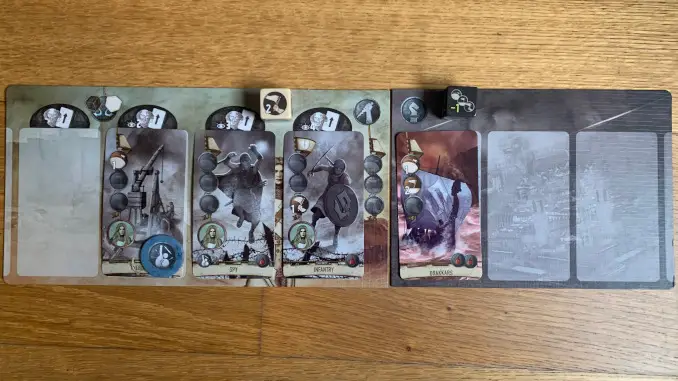
The Attacker and Defender are then assigned their dice depending on how many units they have currently in battle. If there are 3 or fewer units on the Attacker Board, the Attacker gets the Strong die, the Defender gets the Risky die. If there are 3 or more units on the Attacker Board, the Attacker gets the Risky die, the Defender gets the Strong die. The dice are then rolled once and the values yielded are applied for the whole battle.
As you can see in the image above, the Attacker gained 2 Close Combat damage, and the Defender suffered a -1 to all Combat Lines This means that the Attacker had a Long-Range Combat Line value of 1, a Medium-Range Combat Line value of 0, and a Close Combat value of 3. The attacker, however, only has a Medium-Range Combat Line value of 1, all others are at 0.
At this point, the battle actually begins.
Once those dice are thrown, no changes can be made to deployment. The battle then takes place across 3 Lines of Combat – Long-Range, Medium-Range and Close Combat. In order to have a Line fight, players must:
- The Attacker adds up the value of all their units deployed on the Attacker Board related to that Line
- The Attacker adds any bonuses from Tokens or Combat Dice to the value
- The Defender does the same
Damage is assigned starting at the units closest to the Battlefront, so in our example:
- In the Long-Range Combat Line, the Attacker’s Trebuchet did 1 point of damage to the drakkars. The drakkars, due to their penalty from their dice, could not make a Long-Range attack.
- In the Medium-Range Combat Line, the drakkars in-turn did 1 point of damage. This was assigned to the Attacker’s Infantry and destroyed them.
- The drakkars then took 2 points of Close Combat Line damage thanks to the dice, so were destroyed.
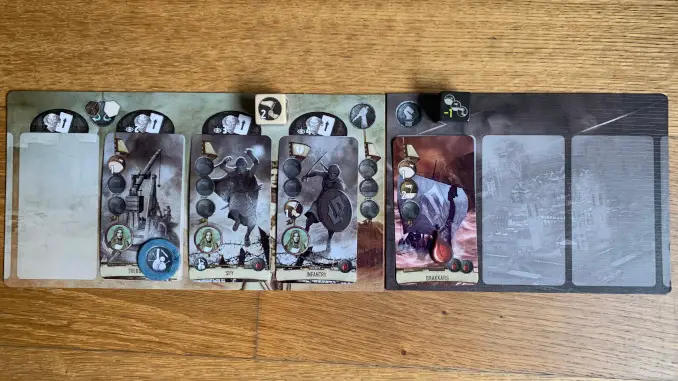
Victory goes to the person with the most cards still in play. With 2 cards not destroyed and the drakkars defeated, this handed victory to me, the Attacker, and meant I could then draw some Relic Cards and pick the one I liked the look of.
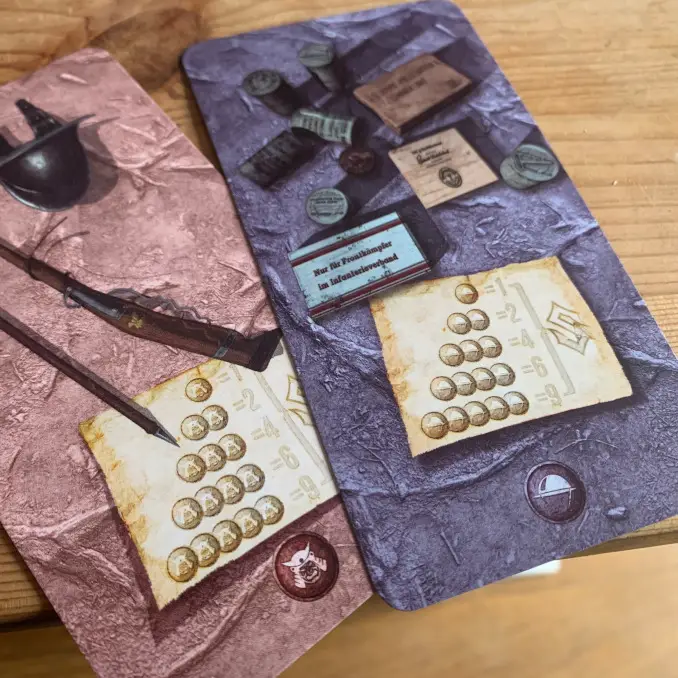
The acquisition of Relic Cards is needed to win the game. The more relics you collect, the better your chance of victory – but you need to try and ensure you collect relics from the same Era to increase the points you score. These are indicated by the values shown on the card. The Attacker can also Recruit any defeated units and add those cards to their discard pile.
Players can also choose to fight each other for different rewards. The course of battle is largely the same as above, but the rewards are different. If the Defender player has lost, they are entitled to take 1 Honour of Arms Token for every 2 of the Attacker’s Units they managed to defeat. The winner, be they Attacker or Defender, takes 2 Prowess in Battle Tokens from the loser, secretly choses 1 and replaces the other.
If the Attacker was the winner in a player-versus-player Battle, depending on how many units they deployed, they may be entitled to take a Relic Card from the Defender.
Phase III: Restoration
Finally, we move on to Phase 3: Restoration. Once the Battle has ended, all units on the Attacker Board – both defeated or otherwise – go into their discard pile. All Warfare Tokens are discarded and all Link Counters are replaced. Any empty spaces on the Main Board must be refilled, be they with new Unit Cards or Warfare Tokens. Players must also draw from their deck until they have 4 cards in their hand again. If they don’t have 4 cards in their deck, then as soon as their deck runs out, their discard pile gets re-shuffled and they can draw again.
And that concludes one player’s turn.
We played for a couple of rounds and slowly picked up the rules, but this came with a lot of head-scratching and referring back to the poorly-formatted rules book. Ultimately, my co-tester and I were in agreement that, whilst the game was ultimately enjoyable, it wasn’t easy to pick up by any stretch of the imagination.
The game was a close one, with both of us loading up on Relic Cards and tokens from battles with each other, but I narrowly clinched a victory over my opponent – in spite of Lizzie’s somewhat uncanny ability to pick these things up far quicker than me.
Playtesting: Thoughts
Sabaton: A Battle Through History is a fun and unique spin on board gaming, blending deck building with interesting historical elements in a sprawling adventure through the annals of the past.
There’s a lot to like here, but the game does need a little bit of work.
The game is good, but, as the warning inside the box says, is also very complex. This itself doesn’t hold the game up, but a poorly-formatted and not always well-written rules manual that fragments rules and explains them across non-consecutive points does complicate the learning process and prevent players from engaging with the game as quickly as they could. Key concepts, such as how damage is allocated during the Battle Phase, is buried deep within other information, and, in this case of this fairly crucial piece of information, wasn’t highlighted or in an alternative font to make it easy to spot at a glance.
Initially, this made it seem like everything in the game was taking an unreasonable length of time to complete. This was uniquely frustrating, given that it felt as if all we were doing was picking up a token (or not), drawing some cards (or not), placing a figure on a quadrant of a board and then either picking a fight with either each other or one or two units from the Main Board.
That said, when it did eventually click and we began to get the game rolling more smoothly, transitions from Rounds and between Phases became much easier, and the game felt much more rewarding. As our decks of cards grew and the combinations that could be used in battles became more expansive, the game seemed to really begin to open up.
However, I do think the Battle system could use some work. Currently, it feels a little bit like every battle is just auto-resolved after two dice are rolled. Perhaps this is because so many of the games I’m used to, and those explored on FauxHammer.com, explore combat to the Nth degree, with spells, abilities, and other interesting ways to keep fighting challenging and entertaining. A Battle Through History’s more hands-off approach to battling – put down some cards, roll a dice, and do maths – whilst likely implemented to try and keep the game moving and ensure things can be resolved quickly, does leave this part of the game feeling a little unfulfilling at times, especially after you’ve lined up that perfect hand.
The deck-building mechanics will separate the glass half-empties from the glass half-fulls. There are so many – I mean so damn many – really cool and interesting cards in A Battle Through History. There’s so much to look at, so much to play around with, and yet there’s a very real chance you’ll do little more than scratch the surface of this aspect of the game during the usual progression of play. With 12 cards on the Main Board at the start of the game, and these only being replaced when they’re claimed by a player, over the course of a 6-round game between 2 people, there’s a chance you may only swap 12 of these cards out for 12 others at a rate of one a Turn for 6 Rounds. I mean, there’s a very real possibility you might not even see one of the 8 Hero Cards.
This is, on one hand, awful, but on the other, great. I was very unsatisfied that so few of the cards were used in the course of our game, but Lizzie very rightfully pointed out that this does, in fact, improve the game’s replay value. With a veritably infinite number of card combinations available, you’re unlikely to get the same hand twice, which keeps the game challenging and interesting.
The game would be better played with 5 people, though that in turn means a) you’ll be playing well beyond the game’s advertised 60-120 minute play time and b) you have the largest dining room table in existence.
Sabaton: A Battle Through History Board Game – Price and Availability
You can grab A Battle Through History from these official Sabaton-associated retailers. Priced at 50€ (about £40GBP/$56USD) before tax and shipping, it’s definitely a fair price for the amount of game you get.
I mean, my box was so full of stuff the sides had literally burst. Either that, or someone kicked it across a warehouse.
Sabaton: A Battle Through History Board Game – Final Thoughts
| Pros | Cons |
| Artwork and design direction is excellent Loads of stuff in the box, so tremendous value for money Interesting and very original concept Amusing miniatures Has the potential to be very educational | Game is extremely complicated at times Rule book leaves a lot to be desired Combat and deck-building mechanics can be a little dissatisfying |
I do like this game – and not just because I’m a Sabaton fan and a big history nerd. What makes Battle Through History great is its unique concept and the way it tries to turn the tried-and-tested tropes of any old deck building game into a fun, tongue-in-cheek, time-traveling experience that is both entertaining and educational.
In fact, the educational value in this game is excellent. Alongside the historical booklet that comes in the box – a small pamphlet which gives a little background on the various units and heroes available – players will likely want to know more about the real-life units in their decks, and will find themselves looking up just who or what their cards are referring to. This is in part due to the excellent artistic direction present throughout this game, that has done a wonderful job of making these units look so great.
But I can’t deny that I’m a little bit disappointed by a couple of things here. I’d hoped to be able to hold up Sabaton: A Battle Through History and gleefully point out that this is another victory for fans of heavy metal. Not only do we produce and listen to the greatest music in the world, but we’re also crushing it elsewhere in the nerdiverse. But I don’t think it’s quite there – yet.
There is a vast amount of stuff in the A Battle Through History box, and just as much stuff to try and pick up in the sometimes poorly-written rules. It’s definitely best played with 5 people, otherwise the sprawling deck building potential in this game just won’t be reached, and this can cast a shadow over the combative elements of the game. But even with 5 players, it’s not an easy game for you to get your head around. This does beg the question: who, exactly, is this aimed at?
You’ve got to be a Sabaton fan in order to enjoy A Battle Through History to its maximum potential. Flicking little models of the band around the game’s Gears of History Board just won’t have quite the same joy to it if you haven’t got a clue who this Chris Rörland bloke is and why he’s dressed in funny clothes.
Alongside being a Sabaton fan, you’re also going to need to be a fairly big board game nut because, as the game warns you, A Battle Through History is hard – so much so, at times trying to figure out the rules with my co-tester reminded me of this hilarious video. If you’re just after a game you can crack out with some friends whilst having a few drinks and some snacks, this isn’t one for you (primarily because all the table space will be taken up with tokens and there’ll be no room for refreshments), but if you’re the right blend of Sabaton superfan, board game boffin, and happen to have a table the size of a football field in your home, you’ll find a huge amount to enjoy in this game
Is there anything you’d like us to cover? Perhaps you’ve spotted a Kickstarter for a new board game on your Facebook page, or stumbled upon a selection of miniatures from a lesser-known artist that you’d love to see a review of? Let us know and we’ll see if we can source something for a review!
Please Note: This site uses affiliate links. Our Affiliate Partners are shown below
(Affiliate links will result in compensation to the site on qualifying purchases)
Click this link & buy your hobby stuff from Element Games for the UK & Europe to support FauxHammer.com – Use Code “FAUX2768” at the checkout for double reward points.




Our Affiliates / Hobby Stores
- UK: Element Games, The Outpost, Wayland Games, Mighty Lancer, Goblin Gaming, Forbidden Planet, Model Scenery Supplies, eBay, Amazon
- US/Canada: MTechCave, GameKastle, eBay (US), eBay (CA), Amazon
- Germany: Taschengelddieb
- Europe: eBay (DE), eBay (FR), eBay (ES), eBay (IT), Amazon
- Australia: eBay, Amazon
- Global: RedGrass Games, Warcolours
- 3D Printers: Phrozen 3D, Elegoo, Anycubic
FauxHammer – Latest Video on YouTube
What did you think of this Review? please let us know in the comments.
If you like what we’re doing here you could really help encourage more content with a share on any social media platform.
Click the share links at the bottom of this screen (or on the left for computers and tablets)
Want to keep updated with the site? You can subscribe in the sidebar for RSS or by email below
(Sidebar is below the article on Mobile Devices)






